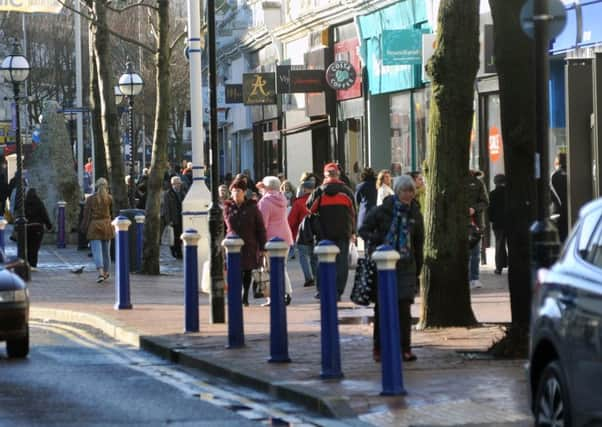Eastbourne has one of the '˜healthiest high streets' in the UK


The Royal Society for Public Health (RSPH) published a league table ranking 70 of Britain’s towns and cities by the impact of their high streets on the public’s health and wellbeing.
Positive influences included pubs and bars, dentists, opticians, libraries, leisure centres, museums and galleries, pharmacies, coffee shops and vape shops.
Advertisement
Hide AdAdvertisement
Hide AdBut points were deducted for betting shops, payday lenders, fast food outlets, off licences, tanning salons and empty shops.
The rankings, based on the prevalence of different types of businesses found in the towns’ main retail areas, see Brighton and Eastbourne make the healthy high street list, at number seven and eight on the list respectively.
Advertisement
Hide AdAdvertisement
Hide AdCouncillor Jonathan Dow, lead cabinet member for place services at Eastbourne Borough Council, said: “These findings are no surprise to people who live and work in Eastbourne. Eastbourne town centre is undergoing a once in a lifetime transformation.
“The centrepiece of this is an £85m redevelopment of the Arndale Shopping Centre. The 170,000 sq. ft extension is being funded by Arndale Centre owners Legal & General and when completed will bring an additional 22 shops to Eastbourne plus an eight-screen cinema and restaurants.
“Eastbourne Borough Council and East Sussex County Council are also working together on a joint project to improve areas within the town centre. This includes the creation of an attractive pedestrian friendly environment along Terminus Road, space for cultural and social activities and enhancements to the wider town centre for local residents and Eastbourne visitors to enjoy.
“Together all these exciting developments will undoubtedly prove another welcome boost for economic growth in the town.”
Advertisement
Hide AdAdvertisement
Hide AdThe top ‘healthy’ high streets were Edinburgh, Canterbury and Taunton.
Grimbsy, Walsall and Blackpool came out as the ‘unhealthiest’ high streets.
Revealing the research today (November 2) RSPH said the average life expectancy for people living in areas with the top 10 healthiest high streets is two and a half years longer than for those in the 10 unhealthiest ranked areas.
Shirley Cramer, chief executive of the RSPH, said: “While the face of the British high street continues to change, the environmental and economic factors that influence inequalities in health outcomes across the country remain stubbornly intractable. Our Health on the High Street rankings illustrate how unhealthy businesses concentrate in areas which already experience higher levels of deprivation, obesity and lower life expectancy. Reshaping these high streets to be more health-promoting could serve as a tool to help redress this imbalance.”
Advertisement
Hide AdAdvertisement
Hide AdThe report said changes to British high streets that have influenced the rankings include:
- A growth in the number of fast food shops by 4,000 between 2014 and 2017, especially in the most deprived areas, which now have five times more fast food shops than the most affluent areas;
- The number of vape shops has doubled from 1,000 to 2,000 in the past three years;
- The high street vacancy rate has increased from below seven per cent in 2007 to 11 per cent in 2017.
Advertisement
Hide AdAdvertisement
Hide AdThe league table features in the new RSPH report, Health on the High Street: Running on empty, which follows on from the announcement by the Chancellor of the Exchequer of a package of measures designed to reinvigorate the nation’s High Streets.
Ms Cramer said: “While we broadly welcome the package of measures announced by the Chancellor of the Exchequer this week, we are concerned that they do not go far enough. Local authorities, who are well placed to make changes, are currently operating with one hand tied behind their backs due to ongoing funding cuts, particularly in some of the more deprived areas that feature prominently in these rankings. Many local authorities are doing good work with the resources they have, but they need to be backed, both financially and with enhanced powers, by central Government if they are to succeed in reshaping high streets for the better.
“The announcement of business rates relief in the budget will be a boost for smaller independent businesses; however, there was no consideration of the unfair advantage online businesses enjoy over the high street, through what is nowadays an outdated means of calculating business rates, based on physical premises alone. Our latest report highlights the impact of online retail, including concerns that this may be one of the factors behind the growth and clustering of empty shops and the devastating impact this has on community wellbeing. We would have preferred to see an overhaul of the business rates system, to ensure there is a level playing field between those ‘real world’ retailers which have a high street presence and provide an important service to support their local communities, and online retailers.”
The public survey was conducted by Populus on behalf of RSPH in May 2018.
Advertisement
Hide AdAdvertisement
Hide AdThe rankings exclude London high streets, which have a separate list.
The top 10 “unhealthiest” British high streets were ranked as:
1. Grimsby
2. Walsall
3. Blackpool
4. Stoke-On-Trent
5. Sunderland
6. Northampton
7. Bolton
8. Wolverhampton
9. Huddersfield
10. Bradford
The top 10 “healthiest” British high streets were ranked as:
1. Edinburgh
2. Canterbury
3. Taunton
4. Shrewsbury
5. Cheltenham
6. York
7. Brighton & Hove
8. Eastbourne
9. Exeter
10. Cambridge
To find out more, visit: www.rsph.org.uk